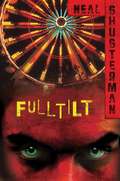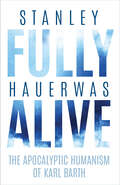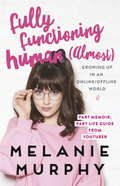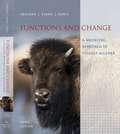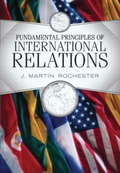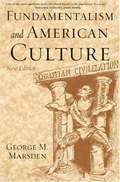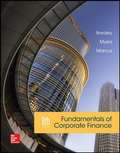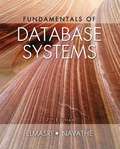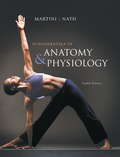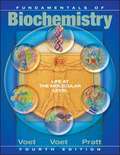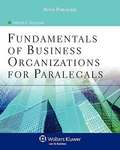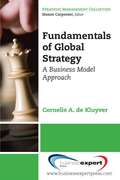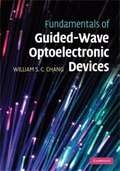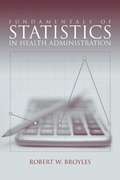- Table View
- List View
Full Tilt (Neal Shusterman Collection)
by Neal ShustermanFull of roller-coaster twists and turns, Neal Shusterman's page-turner is an Orpheus-like adventure into one boy's psyche.Sixteen-year-old Blake and his younger brother, Quinn, are exact opposites. Blake is the responsible member of the family. He constantly has to keep an eye on the fearless Quinn, whose thrill-seeking sometimes goes too far. But the stakes get higher when Blake has to chase Quinn into a bizarre phantom carnival that traps its customers forever. In order to escape, Blake must survive seven deadly rides by dawn, each of which represents a deep, personal fear--from a carousel of stampeding animals to a hall of mirrors that changes people into their deformed reflections. Blake ultimately has to face up to a horrible secret from his own past to save himself and his brother--that is, if the carnival doesn't claim their souls first!
Fully Alive: The Apocalyptic Humanism of Karl Barth (Richard E. Myers Lectures)
by Stanley HauerwasLiving through an apocalyptic time, Swiss theologian Karl Barth influenced Christianity in the twentieth century profoundly. He publicly rejected Hitler’s Nazism, advocated on behalf of workers and laborers, and ministered to prisoners. Barth was named by Pope Pius XII as "the greatest theologian since Thomas Aquinas" and in 1962 even appeared on the cover of Time magazine. In Fully Alive, one of America’s best and most provocative theologians, Stanley Hauerwas, demonstrates that Barth’s radical theological perspective is particularly relevant and applicable to the challenges of our own time.Hauerwas argues that Barth’s engagements with the social and political struggles of his day can help us see what it means to be fully human in the twenty-first century. The ecclesiastical and the political were inseparable for Barth; similarly, Hauerwas shows why it is crucial for theological claims to produce insights that make it possible for our lives to be well lived. Including chapters on race, disability, and the church in Asia, Hauerwas shows how Barth’s political theology can be read as a training manual that can help us maintain our humanity in a world in crisis.
Fully Functioning Human (Almost) (Almost): Living in an Online/Offline World
by Melanie Murphy'I'm just a nitwit girl who's sort-of stumbling through life learning that we all have our own roads to walk - but that it's still valuable, and rather lovely, to hear about other people's journeys . . . ' Growing up in an online age, becoming an internet sensation with half a million followers on her YouTube Channel, Irish girl Melanie Murphy's journey has been far from ordinary. Here, in her first book, she shares the ups and downs of her life. From dealing with online bullying, to living with anxiety and eating disorders to coping with acne and coming to terms with her sexuality, Melanie shows us how through difficult times we can learn the most about ourselves. And that, by learning to value and love ourselves, we can overcome whatever life throws at us.
Functions and Change: A Modeling Approach to College Algebra (3rd Edition)
by Bruce Crauder Benny Evans Alan NoellThis edition provides an alternative to a traditional college algebra course for students who either will not take another math course or may go on to a business calculus course. An informal approach offers clear explanations that leave out unnecessary technicalities so that students who are not comfortable with algebra will easily understand the concepts.
Functions of Life: Processes Essential to Human Life
by Rivka D. BronnerFunctions of Life: Book One is written for the introductory-level student who wishes to develop a basic knowledge of the functions essential to human life. The text provides a solid foundation in anatomy and a thorough coverage of physiology as it presents an overview of each of the body systems.
Fundamental Principles of International Relations
by J. Martin RochesterThis book distills the essential elements of world politics, both the enduring characteristics as well as the revolutionary changes that may be altering the very fabric of the centuries-old state system. Author J. Martin Rochester explores all the important topics that one would expect to find in an IR text (war, diplomacy, foreign policy, international law and organization, the international economy, and more) but injects fresh perspectives on how globalization and other contemporary trends are affecting these issues. In addition, the author does so through a highly engaging, lively writing style that will appeal to today's students. Fundamental Principles of International Relations is a tightly woven treatment of international politics past and present, drawing on the latest academic scholarship while avoiding excessive jargon and utilizing pedagogical aids while avoiding clutter. Rochester ultimately challenges the reader to think critically about the future of a post-Cold War and post-9/11 world that is arguably more complex, if not more dangerous, than some previous eras, with the potential for promise as well as peril.
Fundamentalism and American Culture (2nd edition)
by George M. MarsdenMany Americans today are taking note of the strong political force that is the religious right. Controversial decisions by the government are met with hundreds of lobbyists, millions of dollars of advertising spending, and a grassroots response.
Fundamentals Of Corporate Finance (Eight Edition)
by Richard Brealey Alan Marcus Stewart MyersFundamentals of Corporate Finance, by Brealey, Myers and Marcus, provides students with a solid framework of theory and application to use well after they complete the course. This author team is known for their outstanding research, teaching efforts, and world-renowned finance textbooks, so it's no surprise that they provide clear exposition of difficult material without sacrificing up-to-date, technically correct treatments. And with the Eighth Edition, McGraw-Hill's adaptive learning component, LearnSmart, provides assignable modules that help students master chapter core concepts and come to class more prepared. In addition, resources within Connect help students solve financial problems and apply what they've learned. Brealey's personable writing style and world-leading content combine with a complete digital solution to help students achieve higher outcomes in the course. Connect is the only integrated learning system that empowers students by continuously adapting to deliver precisely what they need, when they need it, and how they need it, so that your class time is more engaging and effective.
Fundamentals Of Database Systems
by Ramez Elmasri Shamkant B. NavatheFor database systems courses in Computer Science This book introduces the fundamental concepts necessary for designing, using, and implementing database systems and database applications. Our presentation stresses the fundamentals of database modeling and design, the languages and models provided by the database management systems, and database system implementation techniques. The book is meant to be used as a textbook for a one- or two-semester course in database systems at the junior, senior, or graduate level, and as a reference book. The goal is to provide an in-depth and up-to-date presentation of the most important aspects of database systems and applications, and related technologies. It is assumed that readers are familiar with elementary programming and data-structuring concepts and that they have had some exposure to the basics of computer organization.
Fundamentals Of Organic Chemistry
by John E. McmurryRetaining the concise, to-the-point presentation that has already helped thousands of students move beyond memorization to a true understanding of the beauty and logic of organic chemistry, this Seventh Edition of John McMurry's FUNDAMENTALS OF ORGANIC CHEMISTRY brings in new, focused content that shows students how organic chemistry applies to their everyday lives. In addition, redrawn chemical structures and artwork help students visualize important chemical concepts, a greater emphasis on biologically-related chemistry (including new problems) helps them grasp the enormous importance of organic chemistry in understanding the reactions that occur in living organisms, and new End ofChapter problems keyed to OWL allow them to work text-specific problems online. Lastly, for this edition, John McMurry reevaluated and revised his writing at the sentence level to ensure that the book's explanations, applications, and examples are more student-friendly, relevant, and motivating than ever before.
Fundamentals of Anatomy & Physiology (8th Edition)
by Frederic H. Martini Judi L. NathThis textbook will serve as an introduction to the inner workings of your body, providing information about both its structure and its function.
Fundamentals of Biochemistry: Life at the Molecular Level
by Donald Voet Charlotte W. Pratt Judith G. VoetVoet and Pratt's 4th Edition of Principles of Biochemistry: Life at the Molecular Level, challenges readers to better understand the chemistry behind the biological structure and reactions occurring in living systems. The latest edition continues this tradition, and additionally incorporates coverage of recent research and an expanded focus on preparing and supporting students throughout the course.
Fundamentals of Business Organizations for Paralegals (3rd Edition)
by Deborah E. BouchouxFundamentals of Business Organizations for Paralegals, Third Edition, offers a concise treatment of all of the forms of business organizations in the United States. The author provides thorough, succinct treatment of all pertinent topics, making this book the ideal choice for instructors who teach a shorter course and need a text that covers critical topics with a more straightforward approach. Attentive To The fundamentals paralegal students need to know, this concise paperback provides: a basic and thorough understanding of all the various types of business organizations in a direct and concise format a discussion of each form of business organization, including the nature of the entity, advantages and disadvantages, formation of the entity, operation and management, transferability of ownership, dissolution, and tax consequences more in-depth treatment of Limited Liability Partnerships and Limited Liability Companies than other texts useful exhibits and charts that highlight important topics and sample forms that are integrated with the textual discussion throughout the book Internet resources in each chapter that direct readers to Internet sites that may provide additional information, forms, or agreements Key Terms defined in the margins for easy reference, practice tips in each chapter that provide pragmatic information for paralegals, lists of relevant websites and of tasks commonly performed by paralegals, and a complete glossary that provides an easy reference for terminology Case Illustrations -- brief summaries of cases that illustrate one of the concepts or topics addressed in the chapter Discussion Questions in each chapter that stimulate class discussion and ensure that students Understand The material a complete ancillary package, including an instructor's manual with a test bank and PowerPoint slides. The Instructor's Manual will also provide additional forms, such as tax forms, not included in the text New to Third Edition: each chapter includes all new discussion questions, Internet questions, and Case Illustrations Chapter 6 discusses Revised Uniform Limited Liability Company Act Chapter 10 discusses new trends in corporate governance, such as the move toward electing boards of directors by majority rather than plurality vote, The move toward eliminating staggered or classified boards of directors, new SEC rules and regulations, And The availability of proxy materials on the Internet coverage of the 2008 financial crisis Clear and To The point, Fundamentals of Business Organizations for Paralegals is an excellent, concise treatment of the basics of business organizations, providing students with a thorough understanding of essential topics.
Fundamentals of Chiropractic
by Marc Micozzi Daniel Redwood Carl S. ClevelandThis textbook introduces and explains basic chiropractic philosophy and history, principles, and applications in practice. In addition to covering chiropractic care techniques, it also discusses anatomy, biomechanics, and physiology, as well as spinal analysis and diagnostic procedures. Key scientific and philosophical issues within the chiropractic community are addressed. Clearly presented material in an easy-to-follow format defines unfamiliar terms, explains and illustrates concepts, and reinforces ideas through review and critical thinking questions. The book's broad scope and discussions of diverse topics make it ideal for students or anyone in the chiropractic community. Topics and content parallel the test plan outlines from the National Board of Chiropractic Examiners, ensuring that all material is relevant, up-to-date, and accurate. Well-known chapter contributors - some of the most respected and influential names in the field - give the book a balanced approach, reflecting the diversity within the profession on issues related to the science and philosophy of chiropractic. Well-referenced discussions include the most up-to-date research. Key terms and critical thinking/review questions in each chapter familiarize the reader with important concepts and promote a solid understanding of the material.
Fundamentals of College Algebra (10th Edition)
by Earl William Swokowski Jeffrey A. ColeThis textbook introduces two-dimensional graphs, polynomial, inverse, exponential, and logarithmic functions, and methods for solving systems of inequalities and plane geometry. Keystroke instructions for the TI-83 Plus and TI-86 calculators are provided throughout. The eleventh edition features 100 new examples and exercises. Annotation ©2004 Book News, Inc., Portland, OR (booknews.com)
Fundamentals of Financial Management (Concise Fifth Edition)
by Eugene F. Brigham Joel F. HoustonThis book is intended for use in an introductory finance course and provides clear concepts and contemporary theory of finance.
Fundamentals of Fluid Power Control
by John WattonThis exciting new reference text is concerned with fluid power control. It is an ideal reference for the practicing engineer and a textbook for advanced courses in fluid power control. In applications in which large forces and/or torques are required, often with a fast response time, oil-hydraulic control systems are essential. They excel in environmentally difficult applications because the drive part can be designed with no electrical components and they almost always have a more competitive power/weight ratio compared to electrically actuated systems. Fluid power systems have the capability to control several parameters, such as pressure, speed, position, and so on, to a high degree of accuracy at high power levels. In practice there are many exciting challenges facing the fluid power engineer, who now must preferably have a broad skill set.
Fundamentals of Global Strategy
by Cornelis A. de KluyverThis book looks at the opportunities and risks associated with staking out a global competitive presence and introduces the fundamentals of global strategic thinking. We define crafting a global strategy in terms of change: how a company should change and adapt its core (domestic) business model to achieve a competitive advantage as it expands globally. The conceptual framework behind this definition has three fundamental building blocks: a company's core business model, the various strategic decisions a company needs to make as it globalizes its operations, and a range of globalization strategies for creating a global competitive advantage. A business model is defined in terms of four principal components: (a) market participation--who its customers are, how it reaches them and relates to them; (b) the value proposition--what a company offers its customers; (c) the supply chain infrastructure--with what resources, activities and partners it creates its offerings; and finally, (d) its management model--how it organizes and coordinates its operations. Globalization requires a company to make strategic decisions about each component of the business model. Market participation decisions include choosing which specific markets or segments to serve, domestically or abroad; what methods of distribution to use to reach target customers; and how to promote and advertise the value proposition. Globalization decisions about the value proposition touch the full range of tangible and intangible benefits a company provides to its customers (stakeholders). Decisions about a company's value chain infrastructure deal with such questions as, What key internal resources and capabilities has the company created to support the chosen value proposition and target markets? What partner network has it assembled to support the business model? How are these activities organized into an overall, coherent value creation and delivery model? Finally, strategic decisions about the global management dimension are concerned with a company's choices about a suitable global organizational structure and decision-making process. We use Pankaj Ghemawat's well-known "AAA Triangle" framework to define three generic approaches to global value creation. Adaptation strategies seek to increase revenues and market share by tailoring one or more components of a company's business model to suit local requirements or preferences. Aggregation strategies focus on achieving economies of scale or scope by creating regional or global efficiencies; they typically involve standardizing a significant portion of the value proposition and grouping together development and production processes. Arbitrage is about exploiting economic or other differences between national or regional markets, usually by locating separate parts of the supply chain in different places.
Fundamentals of Guided-Wave Optoelectronic Devices
by William S. C. ChangOptoelectronic guided-wave devices are used in a wide range of optical fiber communication and optoelectronic systems. In such networks, the electrical and the optical characteristics of guided-wave devices, and the interplay between them, have a profound effect on system design and overall performance. Uniquely, this book combines both the optical and electrical behavior of guided-wave optoelectronic devices so that the interwoven properties, including interconnections to external components, are easily understood. It provides the key concepts and analytical techniques that readers can apply to current and future devices. It also presents the impact of material properties on guided-wave devices, and emphasizes the importance of time-dependent interactions between electrical and optical signals. This is an ideal reference for graduate students and researchers in electrical engineering and applied physics departments, as well as practitioners in the optoelectronics industry.
Fundamentals of Human Physiology (Fourth Edition)
by Lauralee SherwoodThis edition provides scientifically sound coverage of the fundamental concepts of physiology and incorporates pedagogical features that make it interesting and comprehensible.
Fundamentals of Literacy Instruction and Assessment, Pre-K-6
by Martha C. Hougen Susan M. SmarttHougen (College and Career Readiness Initiative: English/Language Arts Faculty Collaborative, U. of Texas-Austin) and Smartt (National Comprehensive Center for Teacher Quality, Vanderbilt U. ) compile 17 chapters by education scholars and researchers from the US who introduce pre-service teachers and parents to teaching fundamental literacy skills in students in pre-K through sixth grade. Chapters are organized by the main components of reading instruction and the typical development of skills, from phonological awareness to fluency to writing, and include recommended assessment practices, in addition to chapters on literacy in the disciplines and current laws, policies, initiatives, and response to intervention. They end with chapters on putting it all together and tips for becoming an effective teacher. They refer to the most recent standards, including Common Core State Standards, the International Reading Association Standards for Reading Professionals, and The International Dyslexia Association Knowledge and Practice Standards for Teachers of Reading. Annotation ©2012 Book News, Inc. , Portland, OR (booknews. com)
Fundamentals of Nursing: The Art and Science of Person-Centered Nursing Care
by Carol Taylor Carol Lillis Priscilla Lemone Pamela LynnThis book intends to help nursing students to develop the blended competencies (cognitive, technical, interpersonal, and ethical/legal) they will need to effectively care for patients in both institutional and community-based practice settings.
Fundamentals of Pharmacology for Veterinary Technicians (2nd Edition)
by Janet Amundson RomichBuild a strong foundation for understanding how medications may help or potentially harm animals. FUNDAMENTALS OF PHARMACOLOGY FOR VETERINARY TECHNICIANS, 2E, follows a body-systems approach making it easy to correlate basic anatomy and physiology with the drugs used to treat diseases of each body system. A strong foundation of drug administration, pharmacokinetics, measurement systems, as well as drug approval and safety provides the concepts necessary to understand drug actions and safe drug administration. A StudyWARETM CD-ROM accompanies the book which provides additional practice via quizzes or games.
Fundamentals of Physics (5th edition)
by David Halliday Robert Resnick Jearl WalkerA very useful book in preparing physics students for careers in science and engineering and future endeavors by contributing to the enhancement of physics education. The fifth edition contains chapter features, viz., Puzzlers, Sample Problems, Problem Solving Tactics, Illustrations, Review & Summary, Questions, and Exercises & Problems.
Fundamentals of Statistics in Health Administration
by Robert W. BroylesFundamentals of Statistics in Health Administration fills the needs of both students and practicing health care managers who must apply statistical concepts and methods to real world health care management problems and issues. It covers the fundamentals of statistics in a user-friendly way, with a strong emphasis on practical application in health administration. The text is highly structured with step-by-step instructions throughout. There is an emphasis on Excel and other commonly used programs, although manual calculations are given careful attention as well.
